At the moment, in addition to lattice supports from a steel angle, in Russia and in the CIS countries, steel multifaceted and bent overhead line supports are becoming increasingly used.
The history of the use and operation of metal poles for power transmission lines in the post-Soviet space has more than half a century. For the first time, a 2-circuit overhead line with a voltage of 110 kV using lattice supports from a steel angle appeared in Russia in 1925. In subsequent years, in connection with the development of the electric power industry, supports were required that could withstand as much as possible negative influence environment, easy to install and transport, durable and easy to maintain. It is precisely these characteristics that have been introduced in the last decade by improved multifaceted steel structures and power transmission line poles made of bent profile.
Classification of steel supports
By appointment
- Intermediate supports support the weight of wires and cables and are not designed for horizontal loads. Used inside straight sections of overhead lines.
- Anchor supports compensate for the difference in the tension of the wires of adjacent spans at the installation sites of transitional supports, in places where the wire cross-sections change. Used on straight sections of overhead lines.
- Corner supports compensate for lateral total loads from the tension of the wires when the route turns. They are installed at the turning points of the VL route. For a rotation angle of up to 30 °, intermediate corner supports are used, for an angle of more than 30 ° - anchor-angle supports with appropriate wire fastening.
- End supports compensate for the one-sided tension of wires and cables at the end of the line. Installed at the ends of the VL route.
- Transitional supports are used to cross overhead lines through natural barriers and engineering structures.
- Transposition supports are used to change the location of the wires on the overhead line supports.
- Branch supports are used to organize branches from overhead lines.
- Cross supports are used to implement the intersection of two overhead lines.
By design
- VL supports with guys
- Free standing poles
- Raised and lowered supports
By number of chains
- single chain
- double chain
- Multi-chain
The range of supplied steel poles for power transmission lines
Our company supplies steel poles with a variety of design features. To place an order for the manufacture and supply of metal poles for overhead lines, it is enough to indicate the marking of a typical pole or transfer KM (KMD) drawings for the manufacture of non-standard poles. All supports are produced in the factory according to the projects developed by the leading scientific institutions of the country. The price of power transmission towers will depend on its purpose, modification, strength and durability.
Metal lattice towers for power transmission lines are spatial lattice structures made of rolled steel and are used for the construction of overhead lines with a voltage of 35-1150 kV. Connections of such elements can be of two types: bolted or welded. The type of connection is largely determined by the conditions of subsequent operation, and affects the method of transportation to the construction site of the overhead line. So, welded structures are considered more reliable and easier to install, but at the same time, due to their size, their delivery to the facility is significantly difficult. Unified power line supports on bolted connections are convenient for transportation and for hot-dip galvanizing, but more labor-intensive in installation.
Lattice steel supports VL are made from low-alloyed rolled steel grade 09G2S or carbon steel grade St3 in accordance with the requirements of GOST 27772-88. All supplied power transmission towers are treated against corrosion by hot-dip galvanizing or coated with a special zinc-filled composite.
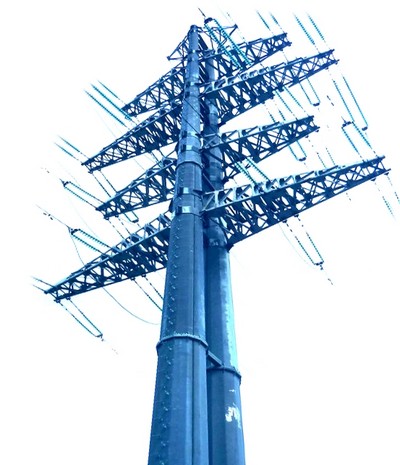
Polyhedral power line supports installed when laying power lines with a voltage of 10-500 kV. They can be operated in I-V ice-wind areas, as well as in populated areas and beyond, provided that the air temperature in these areas drops to 65 degrees.
multifaceted VL supports hollow inside, consist of one or more racks of polyhedral section in the form of truncated pyramids. Rack elements are attached to each other using a flange or telescopic connection. Multifaceted poles are designed and manufactured with different traverses. Traverse structures can be multifaceted, lattice or insulating. Supports and traverses are made from rolled metal grade C345 in accordance with GOST 27772-88. Anti-corrosion treatment is carried out by hot-dip galvanizing or coating with a zinc-containing composite.
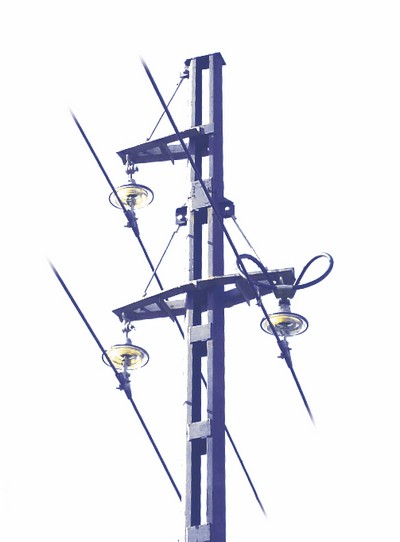
Metal supports VL from a bent profile are used when laying lines with a voltage of 6/10/35 kV. Installation of power transmission towers of this type is allowed in I-VII ice-wind areas with wind pressure up to 1000 Pa and icing thickness up to 25 mm.
Production of power transmission towers from a bent profile for areas with a design temperature of up to -40 ° C, it is made of carbon steel C245 or low-alloyed rolled metal grade C345 for areas up to -65 ° C. All manufactured supports made of bent profile are single-column. All structures of steel racks, traverses, struts, stands are all-welded to reduce assembly units during installation. The supports are fastened to the pipe foundations using a flange or collet connection.
Corrosion protection is carried out by hot-dip galvanizing or coating with a zinc-containing composite.
Metal supports VL 35 kV are indispensable on lines with large electrical loads. The main elements of a metal support are: a metal shaft, foundations, electric linear traverses (metal crossbars on which electric wires are held), cable racks (sharp tops of trunks) and guys.
Anchor supports U transmission lines 35-110 kV are designed for rigid (anchor) fastening of wires at critical points of electrical overhead lines: at intersections engineering structures(for example, railways, electrical lines 330-500 kV, highways the width of the carriageway is more than 15 m, etc.) and at the ends of the overhead lines. The distance between the anchor supports Y is called the anchor span.
By constructive solution trunk metal racks can be tower (single-column) and portal, according to the number of lines: single-circuit power lines and double-circuit power lines. According to the method of installation, the structures are divided into: those installed directly into the ground (reinforced concrete racks SV or SK, which can be bought at reinforced concrete factories) and foundations installed on reinforced concrete (metal poles of power lines manufactured by our company).
Support elements for overhead lines of 35 kV and below, except for traverses and attachments, were previously made of wood: spruce, or, as a replacement option, fir. In the manufacture of power transmission poles, the bark was completely removed from the wood with the removal of the bast, followed by impregnation with creosote. Wooden power transmission poles were made from both round and sawn wood. Ability different breeds wood to be impregnated is different. Pine wood is best suited for impregnation. Spruce and larch are difficult to impregnate, especially their outer layers. Impregnation with antiseptics significantly increases the service life of wooden poles, which is 30-40 years. Today you can meet the dismantling of wooden power transmission towers, the so-called BU, which are replaced by modern reinforced concrete pillars SV or SK.
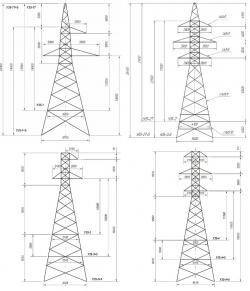 Corner supports VL 35 kv (U35-1, U35-1 + 5, U35-1T, U35-1T + 5, U35-2, U35-2 + 5, U35-2T, U35-2T + 5, U35-3, U35-3 + 5, U35-3 + 9, U35-4, U35-4 + 5, U35-4 + 9) are much more complicated and more expensive than intermediate ones, they are mounted at the angles of rotation of electrical lines, and therefore their number on each line should be minimal. Corner supports mounted on straight sections of the overhead line route for crossing various engineering structures and natural barriers, as well as in places where the number of wires or their sections and grades change, perceive all the efforts that are directed along the overhead line, - the difference in tension of wires and cables in adjacent anchor spans or tension of the wires during their installation.
Corner supports VL 35 kv (U35-1, U35-1 + 5, U35-1T, U35-1T + 5, U35-2, U35-2 + 5, U35-2T, U35-2T + 5, U35-3, U35-3 + 5, U35-3 + 9, U35-4, U35-4 + 5, U35-4 + 9) are much more complicated and more expensive than intermediate ones, they are mounted at the angles of rotation of electrical lines, and therefore their number on each line should be minimal. Corner supports mounted on straight sections of the overhead line route for crossing various engineering structures and natural barriers, as well as in places where the number of wires or their sections and grades change, perceive all the efforts that are directed along the overhead line, - the difference in tension of wires and cables in adjacent anchor spans or tension of the wires during their installation.
Anchor supports of 35 kV transmission lines are designed for installation on high-voltage power lines with a voltage of 35 kV, operated in areas with design temperature air up to -65˚С and above. Metal anchor supports VL represent a metal spatial frame, assembled from metal angle bars on bolted joints or by electric welding.
The metal supports of power transmission lines are a lattice metal structure assembled from rolled steel using bolts and nuts, or welded elements connected by welding.
The installation of metal poles for power lines is a complex, responsible, labor-intensive work, significantly different from the installation of reinforced concrete poles on the overhead line. Features of installation at a height, in the first place, are associated with significant dimensions and a large mass.
Often the work is done in cramped conditions. It is necessary to mount only two (sometimes three), as a rule, identical metal supports located close to each other. To perform the work requires the use of special rigging, often very heavy. The installation of power transmission towers is carried out according to individual detailed designs for the production of works. The choice of installation method for power transmission lines should be made taking into account the design of the support, its height and weight, the size of the installation site, the availability of rigging elements and fixtures for builders, as well as the skills and experience of installers.
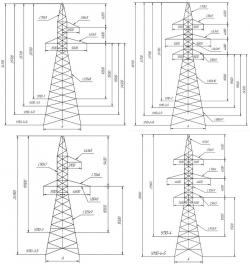 Anchor supports 110 kV -3, U110-3 + 5, U110-4, U110-4 + 5) on straight sections of the 110 kV overhead line with suspension electrical wires on both sides in normal conditions they perform the same functions as the intermediate electrical supports. But anchor supports 110 kV are calculated for the perception of one-sided tensions on wires and cables in the event of a break in electrical wires or cables in the adjacent span.
Anchor supports 110 kV -3, U110-3 + 5, U110-4, U110-4 + 5) on straight sections of the 110 kV overhead line with suspension electrical wires on both sides in normal conditions they perform the same functions as the intermediate electrical supports. But anchor supports 110 kV are calculated for the perception of one-sided tensions on wires and cables in the event of a break in electrical wires or cables in the adjacent span.
The production of metal supports for power transmission lines is carried out from steel angle bars. The mass of the structure consists of the mass of rolling elements and the mass of fasteners. High transitional supports can be made of steel pipes.
For the production of metal structures of power transmission lines of types VL: P, U, US, etc., an angle profile and sheet material (gussets, shoes) are used as the main material. At the same time, the largest volume is made up of parts from an angle profile from 40 to 80 mm and gussets.
Shoe - the lower part of the metal support of the power transmission line, which serves to transfer the load from the support to the foundation. The shoe consists of a steel base plate, a gusset and stiffeners. The support is attached to the foundation with anchor bolts.
Fasonka - metal detail in the form of a small plate sheet metal, which serves to fasten various metal structures, for example, in the node of the lattice rods and the belt of the power transmission line truss.
The simplest gusset is made in the form of a rectangle or trapezoid. It is used when attaching corners and other profiles to other corners or belts of the power line grid.
A gusset made in the form of an elongated parallelogram with cut corners along a long diagonal is called a "fish". Such a gusset is usually used when attaching the diagonal longitudinal corners of the lattice supports of power transmission lines to each other. When designing metal structures of power transmission lines from round pipes, the gusset for fastening the transverse beams can be made in the form of a sector of a circle. The thickness of the gusset is taken, depending on the efforts in the corners, within 8 - 25 mm.
Electric poles of 35 kV overhead lines with bolted connections are convenient for hot-dip galvanizing, economical during transportation due to the compactness of parts packages. Corrosion protection, depending on the customer's requirements, is carried out using hot-dip galvanizing, zinc-filled composite coating, or BT-577 primer.
The metal support of the power transmission line has the following advantages:
- The possibility of creating a metal structure of power transmission line poles, designed for very high mechanical loads, allowing you to place a large number of electrical wires and almost unlimited height, which allows you to build two- and multi-circuit electrical poles, convenient for installation in cramped places.
- Relatively low mass of the power transmission line pole and high mechanical strength: under the same loads and height, metal poles are about 2 times lighter than wooden ones and 8 times lighter than reinforced concrete ones.
- Ease of prefabrication and manufacturability of assembly on the electric track.
- The best architectural solution.
- Metal poles of 35 kV overhead lines have less weight and high mechanical strength than reinforced concrete poles, which makes it possible to create poles of considerable height, designed for heavy loads.
Anchor-corner electric supports 35 kV type U35
|
Name |
Height to bottom |
Power transmission tower weight |
VL support weight |
|
U35-1 |
10 |
2964 |
3080 |
|
U35-1+5 |
15 |
4549 |
4727 |
|
U35-1t |
10 |
3140 |
3263 |
|
U35-1+5t |
15 |
4725 |
4919 |
|
U35-2 |
10,5 |
4831 |
5020 |
|
U35-2+5 |
15,5 |
6591 |
6850 |
|
U35-2t |
10,5 |
5004 |
5200 |
|
U35-2+5t |
15,5 |
6769 |
7033 |
|
U35-3 |
10 |
1635 |
1700 |
|
U35-3+5 |
15 |
2295 |
2385 |
|
U35-3+9 |
19 |
2813 |
2920 |
|
U35-4 |
10,5 |
2799 |
2906 |
|
U35-4+9 |
19,5 |
5067 |
5266 |
Anchor-corner electric supports 110 kV type U110
|
Name |
Height to bottom |
Support mass |
Support mass |
|
U110-1 |
10,5 |
5040 |
5235 |
|
U110-1+5 |
15,5 |
6716 |
6980 |
|
U110-1+9 |
19,5 |
8222 |
8544 |
|
U110-1+14 |
24,5 |
11299 |
11740 |
|
U110-2 |
10,5 |
7704 |
8002 |
|
U110-2+5 |
15,5 |
9717 |
10095 |
|
U110-2+9 |
19,5 |
11391 |
11834 |
|
U110-2+14 |
24,5 |
14643 |
15212 |
|
U110-3 |
10,5 |
3248 |
3375 |
|
U110-4 |
10,5 |
5265 |
5468 |
|
U110-4+5 |
15,5 |
6625 |
6883 |
Energostalkonstruktsiya manufactures metal poles 35 - 500 kV from sheet and angle metal for the construction of power lines. The use of lattice supports is used to connect power lines between consumers and power plants during the construction of power lines. VL network ( overhead lines) stretch for many kilometers, for this, the height of the metal poles of the overhead line is made such a height that the wires on the poles hang at a certain level.
Types of power transmission line supports
- Intermediate- the most massive type of power transmission line supports, which serve to support cables and wires at the required level. These metal power transmission poles are not designed for heavy loads, higher wire tension.
- Anchor angle - are applied on turns of routes and for a tension of wires of the high voltage line.
- transitional - are used to overcome engineering and natural obstacles, usually they are much higher and more massive than intermediate supports, because of this, this type of support is indicated by stripes in red and White color, sometimes by night lights, for better conservation steels are galvanized before painting.
- Terminal - are used at the end or at the beginning of power transmission lines, placed in front of electrical substations on the portals of outdoor switchgear.
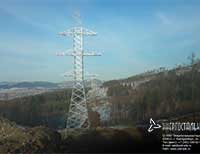
|

|

|
Production stages
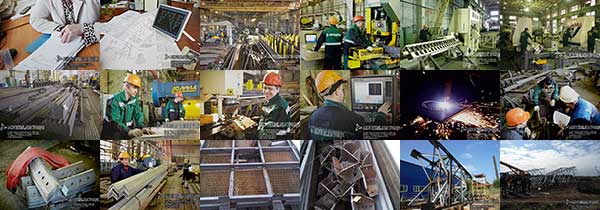
Conditional designation system for metal supports 35 - 330 kV.
Intermediate supports- (P, PS);
Anchor angle supports- (AU, U, US);
End supports - (K, KS);
Intermediate transitional supports - (PP);
Intermediate corner supports - (PU, PUS);
Anchor supports - (A);
Intermediate with internal connections - (PVA);
Reinforced concrete supports - (B); - (except poles 500 kV)
Polyhedral supports of power transmission lines - (M)
Steel supports- (B);
Intermediate composite supports for power transmission lines - (PC);
The voltage class of power transmission line supports is indicated by numbers after the letters. The letter "T" of the supports indicates a cable rack with two cables, the letter "P" indicates the transfer of wires from the lower or upper tier to the middle one. The number of chains is shown by the number after the "-": odd - single-circuit support, even - double-circuit, multi-circuit, standard. "+" shows the height of the attachment to the base support. Designations correspond to the design documentation of manufacturers and may differ from the accepted form.
Examples:
- 110P-1TM/AS35 - anchor, Power transmission line 110 kV and 35 kV, metal, from a bent profile, steel;
- U220-1 + 9 - anchor-angle, metal,
- U220-2t - anchor-angle overhead line 220 kV, double-circuit with two cables, metal;
- PB110-4 - intermediate overhead line 110 kV, double-circuit, reinforced concrete;
- PM110-4f - intermediate overhead line 110 kV, multifaceted, double-circuit with a structurally separate foundation, metal.
- PK110-1 - intermediate overhead line 110 kV, single-circuit, composite;
- PK10-2I - intermediate overhead line 10 kV, composite.
Production of metal supports for power transmission lines at the plant of Energostalkonstruktsiya LLC, both according to unified drawings and according to customer drawings. We design metal lattice supports Power lines 35, 110, 220, 330, 400, 500, 750 kV are engaged in our factory, design department. Energostalkonstruktsiya produces and ships with its own vehicles or rail, metal poles of power lines of any complexity.
Buy
Steel Structures Plant Energostalkonstruktsiya LLC manufactures power transmission towers and other metal structures used in the construction of power grid supports. The price depends on the steel grade and the anti-corrosion coating of the structures of the lattice steel supports. Buy power transmission towers at a price that suits you. Orders are shipped directly to all corners of Russia and neighboring countries, including Kazakhstan.





